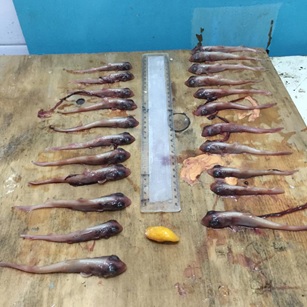
Dissection of a smooth-hound shark
Posted by Jamie Halkyard, Megan Peterson & Claudia Bucher on January 27, 2016
Dissection of a smooth-hound shark and its findings
In our first week as Oceans Research interns, we were invited to attend a lesson on suturing at the local vet clinic - Hartenbos Animal Hospital. The veterinarian discussed the methods by which acoustic transmitters can be implanted into sharks and introduced the tools required. He first performed the procedure on a large strip of leather, and then let field specialists Ralph and Justin practice while we observed. Ralph needed to learn this skill for his PhD project; studying the ecology and movement of two benthic catshark species - the pyjama catshark (Poroderma africanum) and the leopard catshark (Poroderma pantherinum).
On the morning of September 10th 2015, we entered the aquarium lab to find Enrico Gennari, Paul Cowley and Ralph Watson alongside a female common smooth-hound shark (Mustelus mustelus). The shark in the aquarium lab was previously found stranded on the shore of the Klein Brak river in March this year. Since Ralph had already spent time extensively practicing the technique on the leather he now had the opportunity to practice on real shark skin which is much tougher than the practice leather. There are currently no published papers documenting the reproductive biology of smooth-hounds in this river, so Enrico, Paul and Ralph were taking the opportunity to dissect and collect data that may help determine why mature females were found here. Some of the ideas mentioned were if the water temperature or plentiful resources were playing a role, and also if it was a site used for breeding or pupping.
Ralph started by making an incision and practiced the process as if he was about to implant an acoustic transmitter into a live shark. He was aiming for the timing of the entire procedure to be under 3.5 minutes. This timing is important so that the shark experiences minimal stress and is able to be released back into the water safely after being tagged. Before Ralph started each procedure he got us to assist him by holding the shark at each end in preparation for the roles we would play with live shark operations.
After a few attempts, Ralph then proceeded with dissecting the shark, cutting from the underside above the pectoral fins and ending just before pelvic fins. The intestines, stomach and liver were removed and there was nothing significant found in the stomach apart from possible fish residue. We were really surprised to see what a large proportion of the body the liver covers and enquired to Enrico about why this was. He told us the liver is important for buoyancy in sharks and to demonstrate this he removed a small section of it, placed it into a container of water and we watched as it floated.
An incision was then made in the two ovaries and 22 shark pups were found - 11 in each ovary. We asked Enrico about the level of development in the pups and he pointed out that although the gills, fins, and eyes were partially developed, the sex of the pups could not be determined. This was because they were too underdeveloped and no claspers were visible to make the distinction. There were also several intact yolk sacs removed during the ovary dissection.
Smooth-hounds are common in South African waters and have seasonal reproduction with each cycle lasting at least a year. The length of the cycle depends on the presence or absence of a resting period in between pregnancies and depending on the size of the females, they can have between 2-23 pups (Smale & Compagno 1997).
Saïdi et. al. (2008) conducted a study on the reproductive biology of smoothhound sharks in the Mediterranean Sea and found that females were mature at a total length of 175-123cm and males between 88-112cm. Mating in these sharks occurred through May-June and it was interesting to read that only the right ovary was functional since the smooth-hound dissected at the aquarium obviously had two functional ovaries.
A small muscle sample, the pups, and the yolk sac were then provided to geneticists and there was evidence of multiple paternity (DNA from two different males). Ilaria et. al. (2015) found that multiple paternity seems to be a common trait across elasmobranch mating across their study of smooth-hound sharks in the northern Adriatic Sea. They indicate that the potential reason for this is due to females avoiding stressful encounters with males.
It was an exciting day for us as we weren’t expecting to see so much during our first shift at the aquarium. Through our university studies we have dissected fish specimens and read about shark dissections but never had the privilege of watching one in person. The dissection made us realise how much information can be gained by making the most out of each opportunity.
References:
-Ilaria A. M. Marino, E. R., Gristina, M., Rasotto, M. B., Zane, L. & C. Mazzoldi. (2015). Multiple paternity and hybridization in two smoothhound sharks. Scientific Reports 5: Article no. 12919.
- Saïdi, B., Bradaï, M. N., & A. Bouaïn. (2008). Reproductive biology of the smooth-hound shark Mustelus mustelus (L.) in the Gulf of Gabès (south-central Mediterranean Sea). Journal of Fish Biology 72: 1343-1354.
-Smale, M. J., & L. J. V. Compagno. (1997). Life history and diet of two southern African smoothhound sharks, Mustelus mustelus (Linnaeus, 1758) and Mustelus palumbes Smith, 1957 (Pisces: Triakidae). South African Journal of Marine Science.18: 229-248.